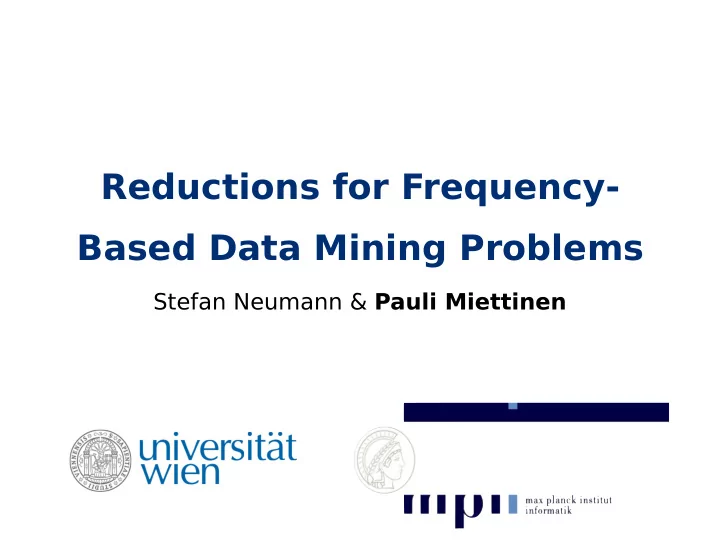

Reductions for Frequency- Based Data Mining Problems Stefan Neumann & Pauli Miettinen
Maximal Frequent Patterns • A pattern is a subset of the data entities • itemset, subgraph, subsequence, … • A pattern is frequent if it appears su ffi ciently often in the data • A frequent pattern is maximal if it is not contained in any other frequent pattern • Studied since 1990s
Computational Complexity • Comp. complexity of maximal pattern mining surprisingly unknown • Potentially exponentially many max. patterns ⇒ takes exponential time • More fine-grained answers: • Time w.r.t. input and output (enumeration complexity, Johnson et al. 1988) • Time spent to count the number of maximal patterns (counting complexity, Valiant 1979)
Reductions • A can be reduced to B if we can solve A e ff ectively with an algorithm to solve B • ” B is at least as hard as A” • In this talk : maximality-preserving reductions between frequent pattern mining problems • ”Maximum X mining is at least as hard as maximum Y mining”
State of the Art Sequences with Undir. graphs no repetition Directed cyclic graphs with treewidth ≤ 3 MaxSQS MaxFS( DAG ) MaxFS( BTW 3 ) Undir. graphs with degree ≤ 3 MaxFS( BDG 3 ) MaxFS( T ) Undir. trees MaxFS( PLN ) MaxFS( DirG ) MaxFIS Planar undir. graphs Directed graphs MaxFS( G ) Itemsets Uniquely labelled undirected graphs A → B = A can be reduced to B
Maximality-Preserving Reductions MaxSQS MaxFS( DAG ) MaxFS( BTW 3 ) MaxFS( BDG 3 ) MaxFS( T ) MaxFS( PLN ) MaxFS( DirG ) MaxFIS MaxFS( G ) These reductions preserve enumeration and counting complexity A → B = A can be reduced to B
Impressed? • Why no more reductions? • Example: From MaxFS( G ) to MaxFIS • Each edge { u , v } has a unique label ( l ( u ), l ( v )) • Make the edges as items and graphs as transactions • Mine maximal frequent itemsets • This doesn’t (quite) work!
What’s Wrong? tid A–B A–D B–C B–D C–D A B C D 1 1 0 1 0 1 A D C B 2 0 1 1 0 1 3 1 0 0 1 1 A B D C Frequent itemsets (minfreq 2/3): Not connected! (3) (2) (2) C D A B A B C D (2) (2) B C B C D
Feasible Patterns • T o be able to encode the connectedness, we need to constrain the feasible patterns • We can adjust our reductions to work with these constraints. E.g.: • maximal graph patterns must map to maximal feasible itemsets, and • it must be easy to compute the graph patterns from the feasible maximum itemsets • These constraints are transitive
Maximality-Preserving Reductions for Feasible Patterns MaxSQS MaxFS( DAG ) MaxFS( BTW 3 ) The complexity collapses under these reductions! MaxFS( BDG 3 ) MaxFS( T ) MaxFS( PLN ) MaxFS( DirG ) MaxFIS MaxFS( G ) A → B = A can be reduced to B
Maximality-Preserving Reductions for Feasible Patterns The complexity collapses under these reductions! MaxFS( BTW 3 ) MaxSQS MaxFS( T ) MaxFS( DAG ) MaxFS( BDG 3 ) MaxFS( DirG ) MaxFS( PLN ) MaxFIS MaxFS( G ) A → B = A can be reduced to B
Summary • For all feasible pattern versions of the problems: • Enumerating all feasible patterns is #P-hard • Given a set of feasible patterns, deciding whether there is any more feasible patterns is NP-hard • Even if only two patterns are given • For any fixed minfreq threshold τ , the enumeration can be done in polynomial time
Conclusions • Most maximal pattern mining problems are essentially equally hard • Methods for one type of problem can be used to solve other types, as well • Feasible patterns admit usually constraints that are amenable to standard level-wise algorithms • Notable exceptions: MaxFS on general graphs and sequences with repetitions • Subgraph isomorphism is NP-hard Ti an k Yov !
Recommend
More recommend